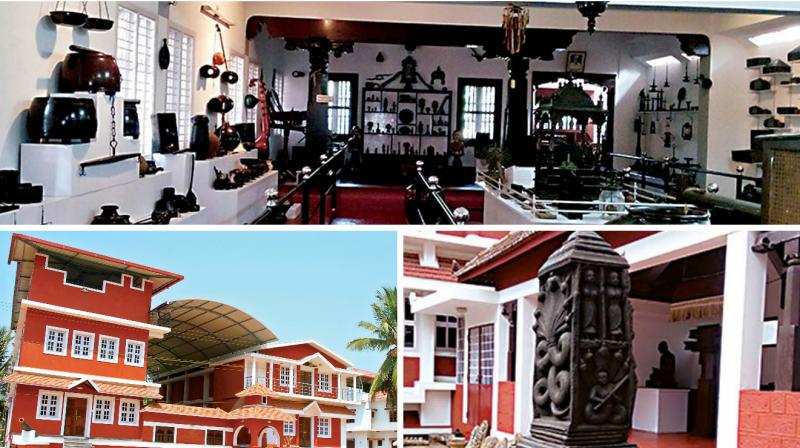A couple's crusade: keeping Tulu culture and tradition alive

The ‘Tulu Baduku Museum’ at Bantwal near Mangaluru preserves memories of the illustrious Tulunadu people. Every object here speaks about the life and culture of the common man of Tulunadu and helps in giving a bird’s eye view of the history of the region. Be it the fan that runs on heat generated by the lamp or the cradle, or the ancient inscriptions and carvings, everything has a story to tell, writes Gururaj A. Paniyadi
Who does not know of the famed people of Tulunadu, of the lovely Aishwarya Rai, of the ‘King of Hearts’ Dr Devi Shetty and businessman R.N. Shetty?
Preserving memories of many such illustrious personalities for future generations is the ‘Tulu Baduku Museum,’ part of ‘Rani Abbakka Tulu Adhyayana Kendra’ in Bantwal, on a narrow road near the BC Road bus stand which houses the rich heritage of Tulunadu. There is an air of history pervading in the building where a huge cannon, hero stones (veera kallu to commemorate valiant soldiers) and inscriptions take any visitor to a totally different world which existed several centuries ago.
The man behind the project- Prof Thukaram Poojary- enthusiastically explains that the Kendra was built on 35 cents of land adjacent to his house. A visitor does not need much time to walk through the big rooms but the artefacts here are so enthralling that it would take you more than two hours to come out of the museum.
As the name suggests, the museum is related to ‘Tulu Baduku’ or the life of Tulunadu and Tulu culture and its inhabitants, the Billavas and Bunts. There are over 4,000 artefacts which he has collected from various places in Dakshina Kannada and Udupi districts since 1993. The museum in its present form was inaugurated in 2008. Every object here speaks about the life and culture of the common man of Tulunadu and helps in giving a bird’s eye view of the history of the region. Be it the fan that runs on heat generated by the lamp or the cradle, or the ancient inscriptions and carvings, everything has a story to tell about Tulu traditions.
There may be other museums with collections of artefacts related to Tulunadu but at this museum, Prof, Poojary has studied and recreated history in a non-traditional way- through the objects used by people of the region in their day to day life. In addition to rare traditional jewellery boxes, various types of metal and earthen vessels, traditional locks and keys, material used for worship, material used for Kambala and Bhuta Kola (worship of the Godly spirit), there are some very interesting arterfacts which tell you fascinating stories. For instance, there is a cradle in the museum with a partition which is hardly seen anywhere else. “It is a cradle for twins,” says Poojary’s daughter Sindhura. She did her engineering and joined IBM only to quit her job to join her father. She is presently doing her post-graduate diploma course in archaeology!
And there is another rectangular shaped wooden cradle which Prof. Poojary says, is made up of wood from five different trees. “The lower portion on which the child is placed is made from the mango tree. This plank is prepared out of wood that is half burnt during cremation. The belief may be that the child should get rid of the fear of death!” Poojary explains.
And there are weapons to prove how brave the men of Tulunadu were. A palanquin denoting married life and pooja material are all part of the museum. Not to mention amazing items like a traditional, earthen vessel for refrigeration where people used to preserve vegetables and fruits for about 10 days, the horn of an animal used to store oil, a small metal container ‘Ladar,’ where toddy tappers would preserve the permit letter given to them by the British government and hang it around their vest, are the other artefacts. “The life of the common man of Tulunadu reflects in each of the displays at the museum. They have some meaning and a story to narrate about the history of the region. I am collecting everything possible so that anybody who wants to do research, can be helped. If written documents are the traditional material for history, such objects too provide us important information about the common man’s life,” the museum founder says. “For example, there are some material like Taala (a metal plate used for mass food), Petari (traditional suitcase), and Pathaya (wooden box to store paddy). These three items have the same name in Tulu, Arabic and Hebrew! This shows how closely the three languages are linked,” he says.
Teacher couple’s brainchild
If Dr Thukaram Poojary is a history professor at SVS College- Bantwal, his wife Dr Ashalatha S Suvarna is a commerce lecturer. They have saved and contributed their money to build the museum. The centre is built in a portion of the land which the professor had acquired for his house. Some well-wishers and friends too have supported him in his project.
The ‘Adhyayana Kendra,’ has a beautiful gallery with various paintings of Rani Abbakka, the first queen who fought against the Portuguese. The library is named after famous freedom fighter of Tulunadu and Gandhian S.U. Paniyadi.

